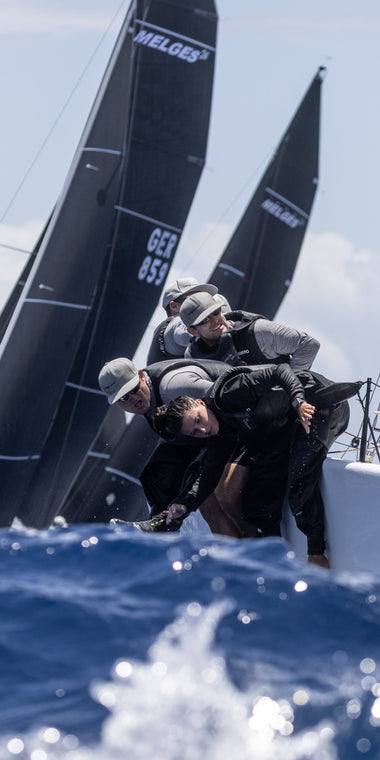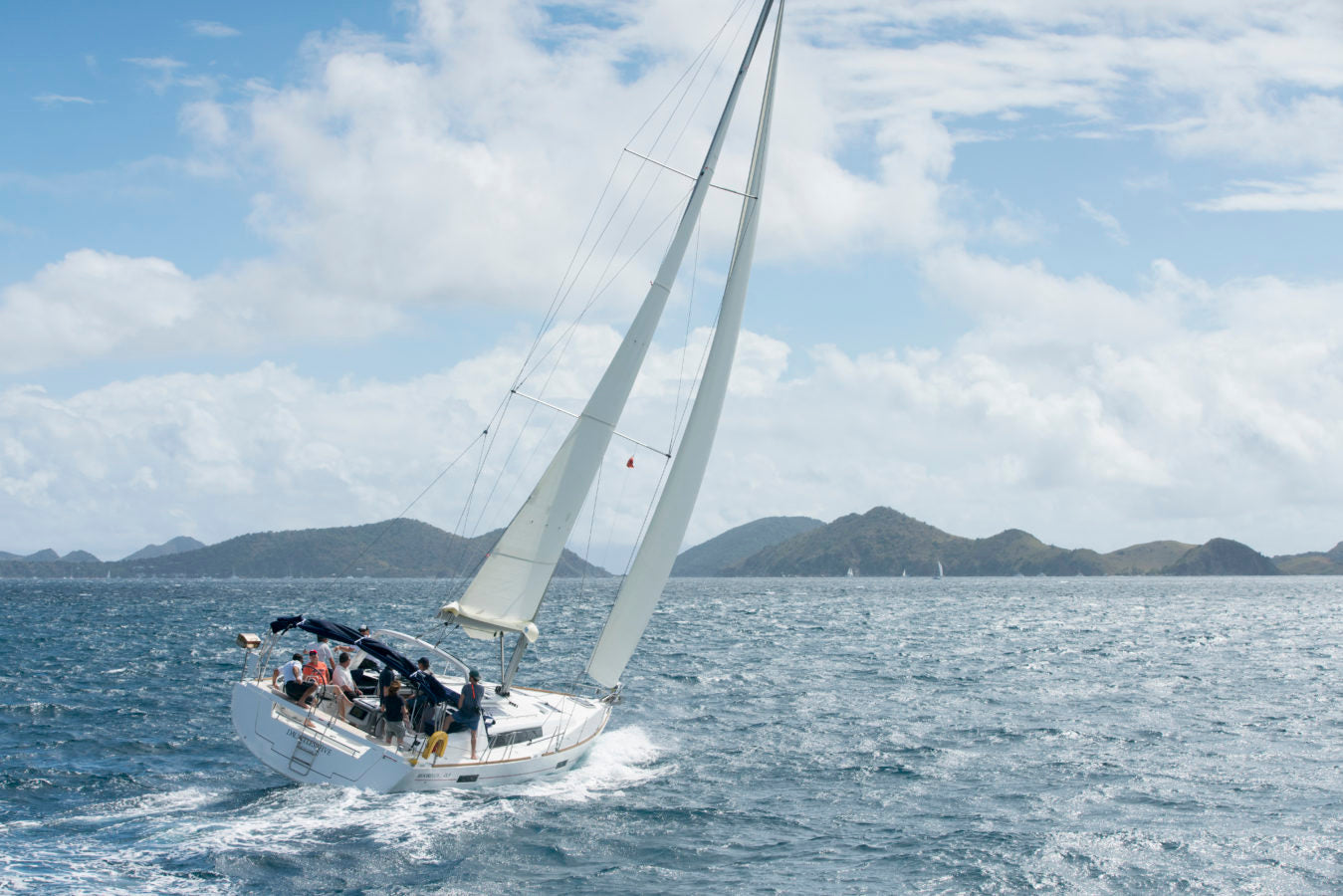CRUISING SAIL TRIM: PUTTING IT ALL TOGETHER
Sources Of Power
Cruising sail trim priorities will vary depending on the wind strength. The easiest trimming condition is moderate winds of 8 to 10 knots, because you trim for full power and indicators like telltales are easy to read. Here’s how to set each source of power.
MAINSAIL POWER
Angle of Attack: Trim the main so the boom is on, or near, the centerline.
Twist: Trim the mainsheet so the telltale at the top batten is flowing most of the time, with an occasional stall.
Depth: Adjust sail depth for a slight weather helm and comfortable angle of heel.
JIB POWER
Angle of Attack: This is primarily controlled through the helm.
Twist: Set the jib leads so that the jib shape matches the main and the telltales break evenly.
Depth: If you can control headstay sag, tighten the headstay to flatten the jib and improve pointing, while maintaining enough power for a slight weather helm and comfortable angle of heel.

JIB LEAD
The jib lead balances high and low shape in the sail. The goal is to set the lead so the sail shape matches the wind from top to bottom. When the lead is set properly, the sail will have a fair curve fore and aft, an even shape from top to bottom, and the inside telltales will break smoothly, starting from the top and moving down. The leech of the jib should match the shape of the main.
-
Moving the lead forward makes the sheet pull down more on the upper part of the sail, trimming in the top. This adds power for extra punch through waves.
-
Moving the lead aft will cause the sheet to pull back on the foot, like an outhaul, without trimming the upper part of the sail as much. This reduces power and allows harder trim, for higher pointing in smooth water.
STEERING TO TELLTALES
Once the lead is set and the jib is trimmed properly, we can use the lower jib telltales as a steering guide. Sail so the inside telltales are streaming aft. When overpowered, head up slightly and let the inside telltale dance. This narrower angle of attack reduces power.
In big chop, add power by falling off a couple of degrees until the outside telltales dance. Be careful not to fall off too far, or the outside telltales will stall and performance will suffer.

SEA STATE
Sea conditions play a big roll in cruising sail trim. In flat seas, very flat sail shapes work well. In wavy conditions, the challenge is to keep enough power to punch through the waves without being overpowered.
From our initial moderate air settings we can fine tune sail shape to match the sea state. The goal is to sustain full power, while adjusting the mix of power to match the sailing conditions. We trade one kind of power for another, while maintaining the same total. Here’s how:
TRIM IN SMOOTH WATER
In smooth water, try a flatter sail shape, with less twist, for higher pointing. You can accomplish this with more mast bend and a tighter headstay. Also, move the jib lead aft to flatten the jib, and then trim the jib sheet harder to take out the extra twist.
Setting the jib lead can be a source of confusion for cruising sailors. Moving the lead aft flattens the foot and adds twist, but in smooth water we want a flat sail with little twist. Move the lead aft to get a flat shape, and then trim the sheet extra hard to take out the extra twist. Result: A flat sail with little twist. With sails sheeted hard and trimmed flat, sail as high as you can (reducing angle of attack) while keeping full power. Don’t pinch, or the boat will stand up and you’ll lose power and speed.
TRIM IN CHOP
For sailing in chop, add extra sail depth for extra punch through the waves, and add some twist for more consistent power as the boat pitches in the waves. Straighten the mast, sag the headstay, move the jib lead forward, ease the sheets a couple of inches to prevent stalling, and bear off a couple of degrees to increase angle of attack.
Once again, we must reconcile lead position with desired shape. We want a deep shape for power, and a twisted shape for a wide groove. Moving the lead forward adds depth but reduces twist. We ease the sheet to restore twist while maintaining the depth and power necessary to punch through the chop.
The challenge in chop is having sufficient power to accelerate after each wave. Set your cruising sail trim with extra sail depth and a wider angle of attack keeps the power on, while the extra twist maintains flow as the boat pitches, and prevents excess heel.

LIGHT AIR
Building speed in light air can be a real challenge. From our moderate air baseline, here are some changes in trim to achieve full power for light air sailing.
Angle of Attack: Bear off a few degrees to increase power. You can’t point high in light air.
Sail Depth: Deep sail shapes are needed. Straighten the mast, and sag the headstay. Keep the headstay just tight enough so it doesn’t flop around. Also move the jib lead forward, and ease the main outhaul. Finally, make sure your halyards are loose to add a few wrinkles along the luff of each sail.
Twist: Light air requires plenty of twist, so keep the telltales flowing. If the sheets are over trimmed, flow will stall.
MOTOR SAILING
In lighter breezes, especially with lingering chop, motor sailing can be a real boon. The extra speed not only improves the motion of the boat; it also creates more apparent wind for the main, which in turn provides more stability. Motor sail your way to fresher breeze. (Hey, it’s not a race.)
One cautionary note: In no wind, you can overload and stretch your mainsail leech if you trim hard and let the sail slat / snap / flop as you motor through waves. If you can’t keep the main from slatting, take it down to prevent damage.
HEAVY AIR CRUISING SAIL TRIM
When properly trimmed, the boat will sail at a moderate angle of heel, with sufficient power to fight the prevailing seas. So when the boat develops an uncomfortable amount of heel or strong weather helm, it’s time to de-power the sail plan – but how?
THE SEQUENCE FOR DE-POWERING RUNS SOMETHING LIKE THIS:
1. Reduce power by flattening sails:
-
Bend the mast
-
Tighten the outhaul
-
Reduce headstay sag
-
Move the jib lead aft
2. Reduce power from angle of attack:
-
Feather the boat up (head up slightly) Lower the traveler
3. Reduce power from twist
-
Ease sheets a few inches
4. Reduce Sail Area
-
Roller-furl a few turns to make the jib smaller, or…
-
Change to a working jib
-
Reef the main
-
Stow the jib and motor sail
OVERPOWERED!
If you do everything you can to reduce sail power with the sails you’ve got up, and you are still overpowered, it’s time to reduce sail area. Generally it’s best to reduce jib size first, then reef the main, and finally stow the jib and motor sail. For more details, read Heavy Weather Sailing Techniques.
Learn more about genoa cruising sail trim here.




























